Parts Washers
Parts Washers complete one of the last steps in the parts manufacturing process; they are designed for the precision cleaning, degreasing, and drying of mass quantities of small or large parts in preparation for surface treatment and distribution. Newly machined, forged, or fabricated products are usually coated in oils, chemicals, burrs, abrasive dust, debris, paint, and other residue left over from the fabrication process; finishing coatings such as zinc and electroplating are not effective if they are applied on a dirty surface. Parts washers solve these problems by cleaning them.
Quick links to Parts Washers Information
Applications of Parts Washers
Industrial parts washers are used extensively to clean carbon, grease, metal chips, cutting fluids, or other contaminants off various metal pieces. Their application ranges from small metal pieces, such as nuts, fasteners, and screws to large metallic bodies, including automotive assemblies, rail bearings, diesel engine blocks, and even wind turbine gearboxes.
In addition to industrial manufacturers, the electronics, automotive, and medical industries frequently use industrial cleaning equipment. They clean equipment, furniture, and technologies that require painting, powder coatings, zinc coatings, lubricants, electroplating, and other surface treatments that would not be possible without thorough parts washing.
Advantages of Parts Washers
There are many advantages to parts washing. These include:
- Low Maintenance Costs
- Low Power Requirements
- Energy Efficiency
- Ease of Use
- Diversity of Method Choice
- Abundance of Eco-Friendly Process and Solvent Options
The History of Parts Washers
Parts cleaning technology was first developed in the mid-twentieth century for use in automotive transmission and engine repair shops. There, parts washers improved upon the previous “soak tanks,” which were simply vats filled with detergent and water in which mechanics placed parts to soak for hours. Parts cleaning equipment and systems made the process of rinsing soiled parts much faster, easier, and more effective.
Initially, solvents were composed of mineral spirits, naphtha, or organic trichloroethylene, xylenes, and benzene. The system of cleaning was simple: a low amp, flame-tight electric liquid pump skimmed the dirty metal piece with solvent in drum washers or rotary drum parts washers until it was cleaned.
In the late 1960s, manufacturers began refining their methods in order to lessen environmental impact and improve safety. At that time, they transitioned from using degreasers like gasoline, diesel fuel, and kerosene, to slightly gentler cleaner and degreaser types, like vapor degreaser and chlorinated solvents. In the 80’s, chlorinated solvents for parts cleaning were banned. After that, aqueous-based cleaning systems, which were first developed in 1971 by Gary Minkin, became the industry standard. The prominence of aqueous solutions and systems ushered in many improvements, like the use of hydraulic impact pressure, which improved cleaning power.
Today, thanks to a few key changes, lots of parts cleaning equipment and systems are environmentally-friendly. In the past, water-based cleaning solutions were not as effective as chemical cleaning. Today's technology has changed that; the newest forms of parts washers use biomatic parts. They use a heater washer containing a PH neutral cleaning solution combined with a microbe colony that breaks down grease, oil, and other contaminants to give the parts a cleaning that is highly effective and environmentally safe. Another key improvement of modern parts washing has been this integration of CNC programming. CNC programming manages the whole process, saving labor and time.
The future of parts washing is bright; likely, as the years go on, engineers will find ways to make the cleaning systems and processes even more efficient, thorough, environmentally-friendly, and cost-effective.
Design of Parts Washers
Parts cleaning equipment typically consists of a water heater, a filtration system, pumps, scrubbers, brushes and nozzles, and a cabinet.
Water heaters can be gas, electric, or steam powered. The filtration system collects waste and debris generated by the cleaning process. Pumps increase the pressure of sprayers, and scrubbers and brushes help dislodge contaminants from parts. Hot water, detergents, solvents, vapors, acids and alkaline solutions, some synthetic and some natural, are used to break down contaminants and remove them from parts. Cabinets (also called enclosures or housings) are often made of stainless steel, though some cabinets also feature glass and plastic components.
When designing parts washers and systems, manufacturers have many design options. For example, some washers are fully automated and CNC machines adjust settings, while some require manual loading. The parts being washed can be front or back loaded, and they can be washed in a basket, tray, rack system, by a robotic arm, a rotary table, or conveyor belt. Most part washers are aqueous, meaning they use water and a water-based chemical or natural solvent in which they boil, blast, or soak the dirty parts until they have been cleaned. Some solvents have additives, called inhibitors, that impede harmful chemical reactions between an aqueous cleaner and a non-ferrous metal substrate.
Because there are as many types of unfinished parts to wash as there are fields of industrial manufacturing, an industrial parts washer manufacturer will typically offer custom designs. These parts cleaners may be as simple as a stand-alone basket immersion parts, or they may be as complex as a five-step deburring, aqueous tumbling, rinsing, drying, and paint coating machine. Innovative industrial technology makes it possible to combine many parts of the finishing process into one specialized machine.
Accessories for Parts Washers
To make your parts washing projects easier, there are a lot of accessories out there. Some you should consider investing in include cleaning brushes, oil absorbing pads, washer heaters, washer filters, turntables, and parts baskets. Find out if one or more of these are appropriate for your application by talking to your supplier.
Installation of Parts Washers
Every industrial parts washer is different. Learn how to properly install your parts washer by following the instructions offered to you by your supplier.
Proper Care of Parts Washers
For metal parts washers to work optimally, there are a number of things you have to be mindful of.
Here are some expert tips for running your parts washers efficiently for many years.
- Avoid Storage of to-be-Cleaned Metal Pieces
- Parts that need cleaning should be moved directly from the production line to the cleaning resource. Stored parts that have oil and grease on them accumulate more dirt during storage, putting extra pressure on parts cleaning machinery, which results in longer cycle times. This affects operation costs as well as the maintenance and repair costs of the parts cleaning equipment.
- Remove Burrs Before Cleaning
- Metal parts that have burrs complicate the cleaning process by making it difficult for the cleaning detergent or solvent to reach and penetrate the area around the burr. Moreover, burrs can come off during washing, making work harder for the filtration and cleaning systems. Removing burrs before cleaning can make the process easier.
- Don't Put Too Many Parts in a Batch
- If you fill the basket to it's limit, it leaves less space for cleaning action, and this may lead to unsatisfactory cleaning. Reducing load size may decrease output, but it will improve cleanliness significantly because it allows more solvent to access the parts.
- Choose the Right Cleansing Solution
- If contaminants on the metal parts are oil-based, like cutting fluids or coolers, a hydrocarbon cleaning process gives optimum results. If contaminants are water-based, like grinding or lapping compounds, aqueous parts washers perform well. This small consideration can affect cleanliness levels and cycle times.
- Make Sure Your Operators are Properly Dressed
- In manufacturing environments, humans unknowingly transfer contaminants such as oils and strands of hair. This complicates the running of metal parts washers. For that reason, we recommend that the operators wear hairnets, lint-free gloves, work coats, and bodysuits while handling the washers. This clothing will also protect them from potential harm from corrosive wash materials or chemicals.
Parts Washer Standards
Because you will be using your parts washer with workers around, it’s always a good idea to ensure your wash system is OSHA compliant. We also generally recommend asking for ISO and/or ASME certification. These certifications offer general quality assurance. From there, standard requirements are dependent largely on your application. For example, a parts washer used to wash military products needs to meet Mil-Specs.
Things to Consider When Purchasing a Parts Washer
Parts cleaning systems are easy to understand, but selecting the right parts washer for your machine parts is certainly not easy.
To help you choose your wash system, use the list of considerations below.
- What materials are your parts made from?
- How large and what shape are your machine parts?
- Do you need a wash rinse system or just a wash system?
- What type of contaminants do you need to wash from your parts? (carbon, oil, grease, mold release agents, corrosion, dust, metal chips, cutting fluids, etc.)
- How skilled are your engineers in cleaning machine parts?
- What are your environmental safety concerns?
Armed with these considerations, you are ready for the last piece of the puzzle: choosing your manufacturer. How do you find the right industrial parts washer manufacturer for you? Start by browsing our listing above. Check out their websites, and call them with your questions. Be on the lookout for a manufacturer that is not only knowledgeable but also considerate. The ideal manufacturer will use their superior skills to design you a high quality system that fits all of your specifications while respecting your budget and timeline.
Parts Washer Images, Diagrams and Visual Concepts
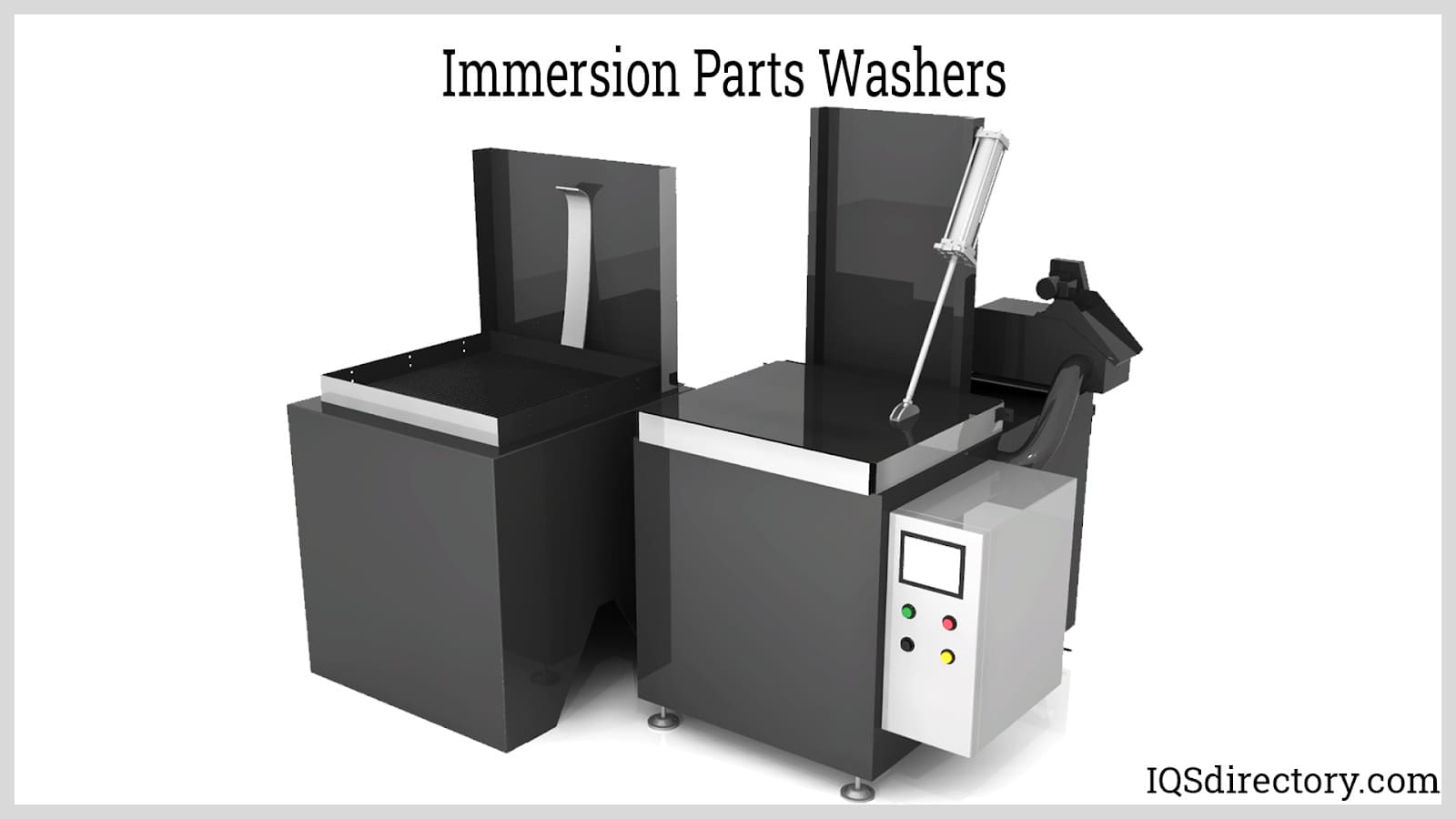 Immersion parts washers uses a system of agitation or oscillation to clean parts in a cleaning solvent.
Immersion parts washers uses a system of agitation or oscillation to clean parts in a cleaning solvent.
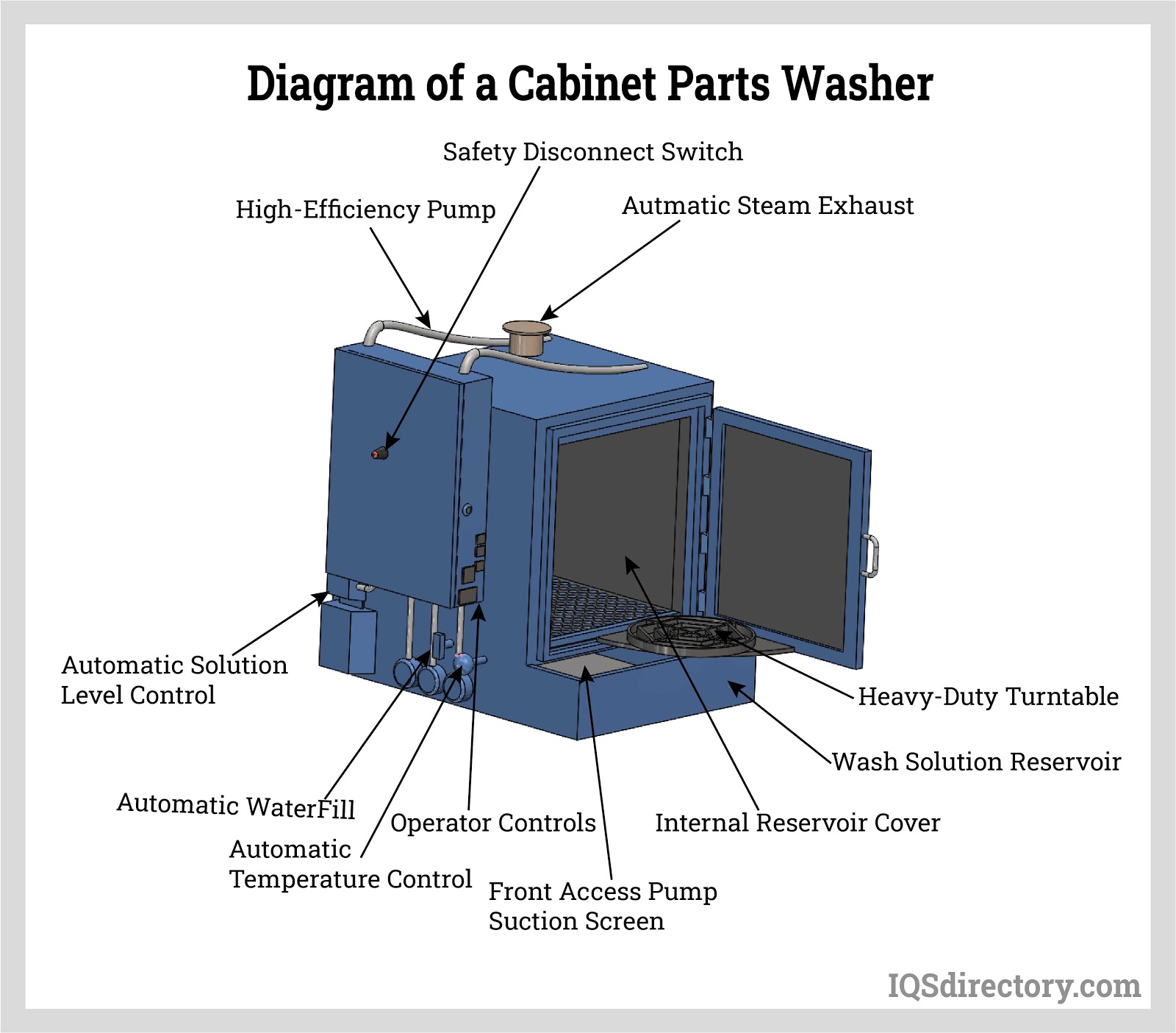 The diagram shows the different parts involved in the cabinet.
The diagram shows the different parts involved in the cabinet.
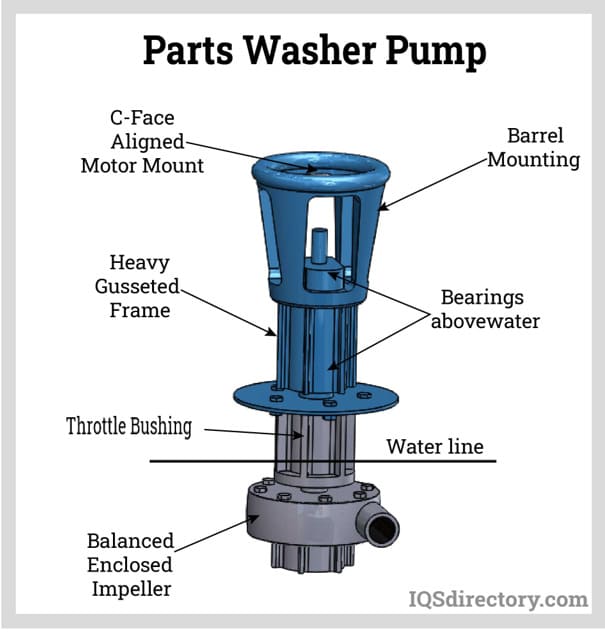 The pump supplies pressure to the system.
The pump supplies pressure to the system.
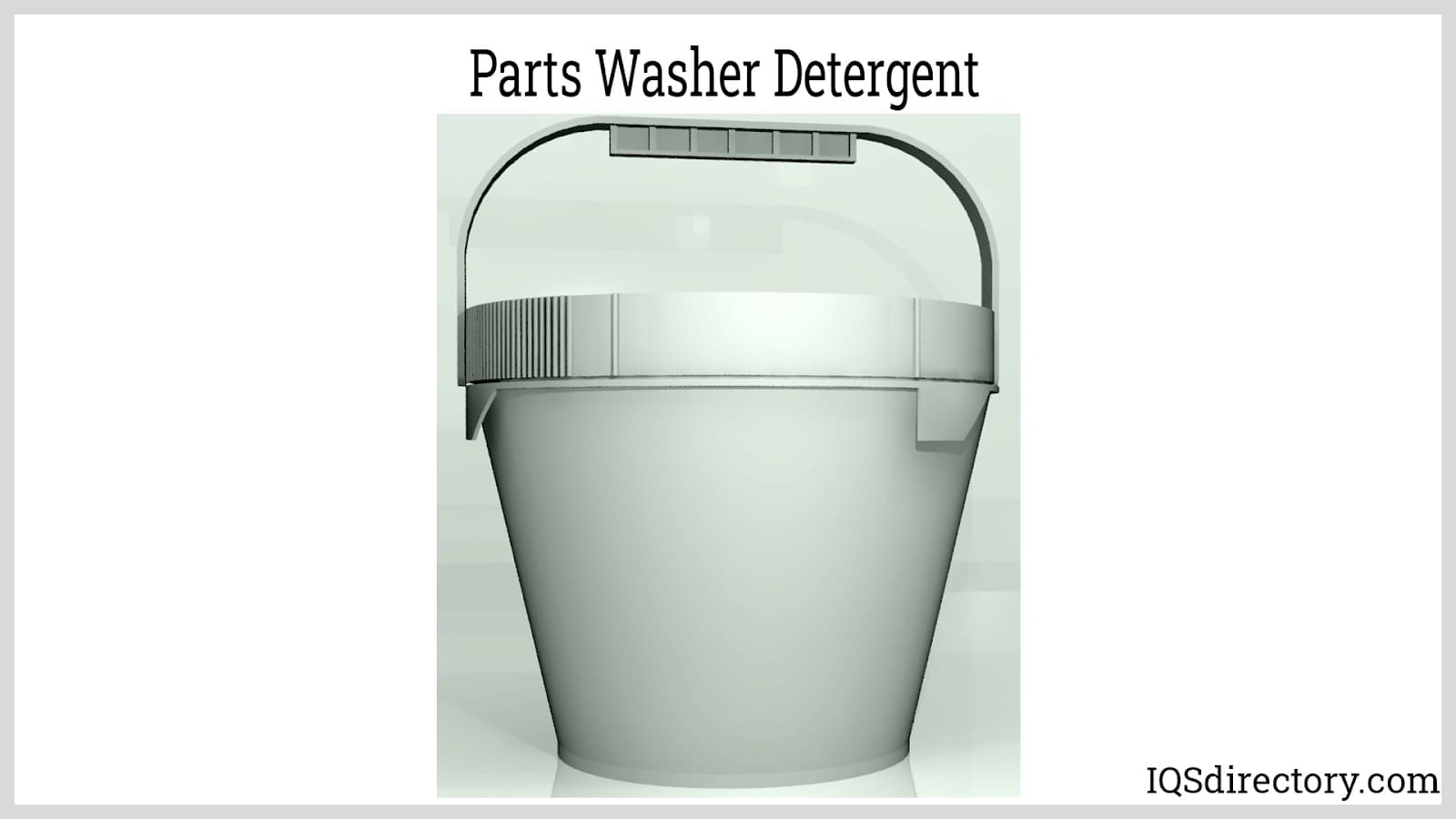 Detergent that can remove grease, grime, oil, chemicals, and soil from high volume parts production.
Detergent that can remove grease, grime, oil, chemicals, and soil from high volume parts production.
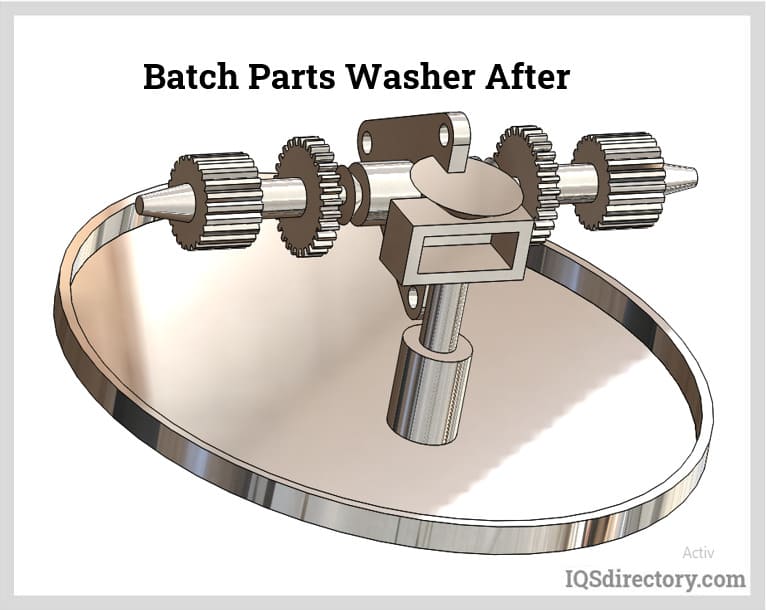 An example of what parts would resemble after being washed.
An example of what parts would resemble after being washed.
Parts Washer Types
Broadly, washers are either solvent or aqueous-based:
- Solvent Parts Washer
- Clean metal pieces by dissolving dirt and scum. The first parts cleaning equipment was only solvent-based and required gallons of petroleum-based solvent; later, more varieties of solvent came. Today, solvent based parts cleaners are no longer as popular as they once were. This is because solvents are often not very eco-friendly, and it’s harder to find solvents that meet environmental safety standards.
- Aqueous Parts Washer
- Use pH-neutral or water-based solutions to break down and clean dirt from metal part surfaces. To increase efficiency, manufacturers do sometimes introduce semi-aqueous cleaning solutions, which have a small amount of solvents, into these systems. The idea is to use detergent and water in combination with mechanical and heat energy to clean; they either use a jet spray or power wash approach.
In addition to these categorizations, parts washer systems can be broken down by their level of automation, from manual to semi-automatic, and, most commonly, fully automatic.
- Manual Cleaning Washer
- This drum or vat style cleaning system is most suitable for low volume cleaning. Ideally, you can follow a manual cleaning routine if your part cleaning processes take about 30 to 40 minutes every day. Additionally, if your processes involve many small parts, this method is fruitful.
- Semi-Automatic Washer
- Feature some automated stages but are not fully automatic. Usually, they require manual loading and unloading, or they work in conjunction with a separate conveyor system.
- Automated Cleaning Washer
- These washers are suitable for operations where parts are cleaned for more than 45 minutes a day. Switching to an automated process could result in significant time and cost savings.
Some modern washers are classified by their functionality:
- Cabinet-Style Parts Washer
- As the name suggests, cabinet washers are in the shape of cabinets. Cabinet style washers use a combination of heated aqueous spray and mechanical energy to wash the grease or carbon from metal part surfaces. Cabinet-style washers are equipped either with a fixed or retracting turntable; the turntable grips and rotates the metal parts during the cleaning process.
- High-Pressure Spray Washer
- Most commonly, these are cabinet-style washers. They operate like common dishwashers found in homes and professional kitchens. However, the sprayer features are more in-depth than those of a standard dishwasher. A high pressure spray machine, or industrial pressure spray machine, employs a high-pressure water jet from different angles to clean machine parts. The spray machine's rotation feature ensures that a maximum number of surface areas are cleaned thoroughly.In general, a powerful stream of water that is rich in aqueous-based chemicals is used for washing the parts. That's why these devices fall under the aqueous part washer umbrella. These aqueous-based chemicals could be a combination of detergent, hot water, and alkaline chemicals. When high pressure meets mild to high temperature, there is no match for cleaning quality.
- Ultrasonic Cleaner
- Relatively new to the industry. These cleaners are composed in a cleaning bath in which the parts are hit by a force of ultrasonic energy. The energy causes the solvent to vibrate, then cavitate, or form bubbles. These bubbles then implode, cleaning surfaces using tiny underwater air blasts and solvents. In addition, ultrasonic cleaning equipment causes contaminants and parts to vibrate and move, making contaminants dislodge more easily. Ultrasonic cleaning is often the most suitable method for removing pollutants from pipes, holes, and unreachable smaller machine areas.
Finally, some other parts washer varieties include green washers, spray washers, rotary drum washers, drum washers, conveyor parts washers, immersion/agitating washers, small parts washers, and automotive part washers.
- Green Washer
- The newest forms of parts washers use biomatic parts. This mixes the best of biology and other scientific research to benefit the environment. The parts are placed into a heater washer containing a PH neutral solution combined with a microbe colony. The microbes then break down grease, oil, and other contaminants to give the parts a cleaning that is highly effective and environmentally safe.
- After the materials are used by the microbes, the hydrocarbons are converted into carbon dioxide and water. The water is then filtered and used again. Oxygen is pumped into the solution to keep the microbes healthy and happy. When this form of system is used, not only is it beneficial for the environment, but it can be reused almost indefinitely, making the entire process cost-effective.
- Spray Washer
- Quite common, are built with an enclosed conveyor belt that moves parts through a spraying water cleaning machine. Usually, the spraying comes from one or more nozzles. They do not necessarily wash products with the same intensity as high pressure spray washers.
- Rotary Drum Washer
- Neither immersion nor spray washers. Instead, they tumble smaller parts through a rotating drum that washes, rinses, and dries the parts. It has a spiral conveyor on the inner wall that moves parts in a circling motion in order to clean all sides. Some washers are designed specifically around the product they are washing.
- Drum Washer
- Used to wash larger drums, pails, and barrels in industrial settings that hold and store different chemicals and materials, such as paint, inks, grease, and adhesives. Each time they are emptied or change the chemical, material, or product they are housing, drums must be thoroughly cleaned. Drum washers must be able to clean the interior and exterior of these containers since both become dirty very easily. Spray washers and rotary washers are the best solutions for these containers since the nozzles can reach the drum interiors. They are then air or heat dried.
- Conveyor Parts Washer
- Unlike cabinet-style washers that use a turntable to hold the metal piece, conveyor washers use a conveyor to move parts continuously throughout the washing process. They either use a simple belt conveyor or an overhead conveyor.
- Immersion Washer/Immersion Agitation Washer
- Also known as agitating parts washers, these vat-style cleaners clean parts by submerging them in a deep, wide bath. They are the most advanced washers, using a combined action of agitation, spray, or ultrasound and a cleaning fluid to remove contaminants.
- Typically, after the parts are underwater and coated in a solvent, mechanical energy creates a vibrating and mixing action via impellers or paddles. Both of these immersion methods are effective in cleaning parts ranging from small to large. In addition, these cleaners are mounted so that the high-pressure spray can clean different areas of the machine parts within a moment. Whether the cleaning arrangement is indoors or outdoors, this method can be ideal. This system is more effective than ultrasonic washing.
- Small Parts Washer
- Either rotary or immersion washers, are designed specifically to handle large amounts of small parts such as fasteners and screws.
- Automotive Parts Washer
- Clean vehicle engines, transmissions, pneumatic parts, and hydraulic parts in hot water solutions and ultrasonic cleaning tubs. Not only do they clean newly manufactured car parts but used parts that have become dirty due to road grime, dirt, and grease as well.
- Agitating parts washers
- Cleaning tools that use agitators to improve the efficiency of the cleaning process.
- Aqueous Cleaning Systems and Aqueous Parts Washing
- The use of water and chemicals to cleanse components. Agitation, rotation, and/or jet spraying along with appropriate detergents, saponifiers, and any other additive required are used to enhance solubility and removal of soil. Aqueous cleaners are basic, acidic, or neutral.
- Automatic parts washers
- Cleaning tools whose operation is controlled by a computer.
- Critical Cleaning
- A cleaning process with extremely specific requirements so that cleaned parts meet highly stringent standards and have some form of measurability integrated into the cleaning process. Industrial cleaning equipment is built to meet extremely strict cleanliness standards.
- Gross Cleaning
- The most common cleansing process used for industrial applications, and it involves the bulk cleaning of products.
- Industrial Washers
- Machines that clean industrial parts.
- Parts Cleaners
- Machines that clean components after they come off the production line.
- Parts Washers
- Mass clean heavy industrial components.
- Parts Cleaning Equipment
- All of the constituent material used in a parts washing system.
- Parts Cleaning Systems
- Machines used for the washing of parts on an industrial scale.
- Parts Washing Machinery
- The group of mechanisms and machines used to clean industrial parts.
- Precision Cleaning
- The cleaning of parts so there are no contaminants at a predetermined level; following processes cannot handle contaminants left from the previous level.
- Ultrasonic Cleaning
- A cleaning process that utilizes vibrations and waves; frequencies between 40 and 400 KHz, emitted by transducer, result in the expansion of air bubbles in a liquid until the bubbles implode in high pressure areas; this is known as cavitation, which causes energy transferals that able to displace contaminants from a substrate surface.
Parts Washer Terms
- Abrasive Media
- A substance for aggressive cleaning, typically sand, garnet, steel, or aluminum oxide.
- Acid
- Any aqueous mixture having a pH less than seven on a 1 to 14 scale. Any acidic solution with a pH lower than three is considered strongly acidic.
- Acid Cleaning
- Cleaning utilizing acids combined with surfactants to remove rust, metal, or scale. Acids with a pH lower than six do not work as degreasers.
- Acid Pickling
- The use of mineral acid to remove scale and rust from metal.
- Knife
- A device that provides a pressurized “curtain” of air for cleansing, cooling, or drying.
- Alkaline Cleaning
- An aqueous cleaning process done with a pH level greater than 7 utilizing phosphates, silicates, or other alkaline salts combined with surfactants in water.
- Biodegradable
- Describes materials that microbial activity can naturally reduce from their original state into simple chemical compounds.
- Bioremediation
- Nature’s way of cleaning using microorganisms (bacteria, enzymes, fungi) to break down the organic compounds in waste or pollutants.
- Blow-Off
- The use of pressurized air to clean or remove excess water.
- Buffers
- Solutions of salt in aqueous cleaning systems that maintain a preferred pH level. Aqueous cleaners use buffers since the precipitation and solubility of metals affect the pH level.
- Builders
- These additives enhance the effectiveness of detergents by sequestering metals like magnesium and calcium. A problem is that a lot of builders contribute to environmental damage with substances such as phosphates.
- Cascade Rinse
- A rinsing process that involves transferring product through a sequence of tanks. The rinse water in the last rinse tank runs over to previous tanks in the sequence (a countercurrent flow). This permits the product to be subjected to progressively purer water.
- Centrifugal Drying
- A drying process using a basket quickly spinning for separation of excess oils, water, or other substances from parts. A turbine fan installed underneath the basket pulling the air through improves the process.
- Closed-Loop System
- A parts cleaning system in which the water is purified, then re-circulated through the system after purification treatment; in aqueous cleaning systems, the water goes back into the wash and rinse tanks and is a cost saving measure. Membrane, reverse osmosis, and ion exchange filtration are typical techniques used to purify the water.
- Conductivity
- The degree to which an aqueous mixture can conduct electricity and an indication of the purity of the water. The level of conductivity is reciprocal to the level of resistance (e.g. the lower the conductivity, the higher the resistance and the greater the water purity).
- Contract Cleaning
- Contracts for cleaning with companies that specialize in cleaning industrial parts and components and provide services to a wide range of industries; these companies provide all encompassing cleaning services, from simple aqueous and solvent cleaning to analytical testing.
- Convection Oven Drying
- A chamber that evaporates water from cleaned components through heated air.
- Corrosion Inhibitor
- A substance used to slow the chemical reaction that causes rust.
- Cosolvent System
- A cleaning process that utilizes at least two solvents to achieve cleaning and rinsing. The action of cleaning results from the combination of the characteristics of each solvent involved; these solvents are selected according to the particular contaminants involved.
- Degreaser
- A solvent or combined material for removing grease, oils, or fat from substrates.
- Deionized (DI) Water
- Water that has enhanced purity resulting from the elimination of ionic species.
- Detergent
- A solution that is a combination of surfactants of hydrophobic and surfactants of hydrophilic material for making grease and oil water soluble. Cleaning is actually done when the soil attaches to the hydrophobic group and when the detergent soil mixture is emulsified in the water; the detergent’s cleaning capabilities are increased through the addition of builders or other additives.
- Diphase Solvents
- Solvent cleaners that have an insoluble aqueous level that is typically utilized along with paint strippers; when combined with denser chlorinated solvents, the water becomes the upper level.
- Dispersing Agent
- This material enhances the stability of particles emulsified in a liquid-solid or liquid-liquid suspension and is also known as an emulsifying agent.
- Emulsification
- The creation of micelles in a cleaning procedure resulting from the dispersal of liquid or solid globules or fine particles into a bulk liquid.
- Eductor
- A device that circulates large amounts of solution in the tanks.
- Filtration
- Cleaning of the cleansing solution and trapping of the contaminants, so the solution can be used for a longer period, and so the components being cleansed don’t retain any of the soil or particulates.
- Hydrophilic
- A surfactant molecule that results in the proclivity of the molecule to be water soluble.
- Hydrophobic
- Describes a water resistant substance.
- Immersion
- Also known as cold cleaning, it is the cleaning that takes place in a tank, usually of a rectangular shape, using an aqueous solution. The cleaning is done primarily through soaking in a water chemical solution.
- Inhibitors
- Additives that impede harmful chemical reactions between an aqueous cleaner and a substrate. Inhibitors typically retard the corrosion process of non-ferrous substrates in high pH or iron.
- Liquid Agitation
- The use of mechanical energy via a circulation pump to circulate a cleaning solution. Effective for components with flat surfaces or those that have a simple configuration.
- Micelle
- An amalgamation of solutions with both hydrophilic and hydrophobic properties that trap non-water soluble oils. Dispersal of detergents and other surfactants results in micelles.
- Nozzle Drying
- The use of nozzles to aim air at specific areas of a component for water removal.
- Pressure Drying
- A process in which a cleansed component with intricate passages is subject to a clamping procedure and forced air enters the passages and dries the part.
- Rinse Stage
- Floods the washed components with clean water or a rinse solution.
- Sequestrant
- A binding agent that prevents chemical reactions.
- Solubility
- A substance's capability to dissolve within another substance, usually a solid in water. Quantification is in grams per liter, and the general classifications for material solubility are fully soluble, partially soluble, slightly soluble, and insoluble.
- Solvent
- In cleaning systems, a liquid substance that cleans a part by dissolving the surface contaminants.
- Sludge
- Heavy soils that sink to the bottom of an aqueous solution.
- Soaking
- Allowing components to rest in a cleaning solution, so chemicals can “lift” the dirt.
- Substrate
- In reference to industrial part washing, any item with a contaminant or soil on it that is being exposed to a cleaning process.
- Surfactant
- An abbreviation of “surface active agent,” it is a common additive for lowering the surface tension between an aqueous cleaning solution and hydrophobic soils in order to loosen the soil or other contaminants. Detergents are principally composed of surfactants.
- Terpenes
- Organic compounds that occur naturally and are usually found in essential oils. Utilized as cleaning agents in semi-aqueous cleaners, they come from natural sources like citrus fruit or pine trees.
- Vacuum Drying
- A process that is particularly useful for evaporation of water at a relatively cool temperature. A vacuum pump is used to dry the product.
- Vertical Part Agitation
- An up-and-down movement of components to allow cleaning solution to remove contaminants; vertical part agitation is effective for parts with cavities.
- Wastewater
- Soiled water from the cleansing process.